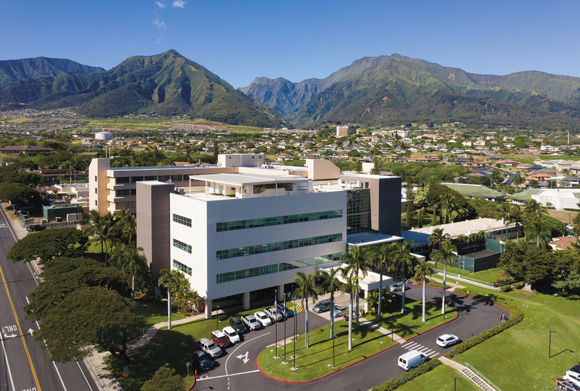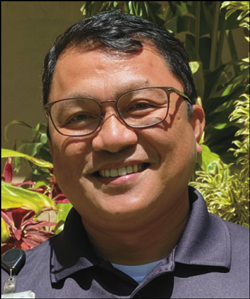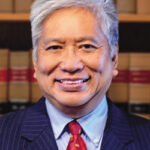Five Years Later: Maui Health is Meeting the Challenges
Alfredo G. Evangelista, Assistant Editor
Five years ago, on July 1, 2017, Maui Memorial Medical Center, Maui Memorial Medical Center Outpatient Clinic, Kula Hospital and Lanai Community Hospital officially became part of Maui Health System (now rebranded simply as “Maui Health”), a system of community hospitals and clinics affiliated with Kaiser Permanente.
History of the Hospital
For over a century, Maui Memorial Medical Center (“MMMC”) and its sister hospital and clinics have cared for Maui residents. MMMC is the successor to Malulani Hospital, established in 1884 during the reign of Queen Kapi‘olani. The earliest official record of the hospital is in an 1866 report generated by the Board of Health to the Legislature, Kingdom of Hawai‘i. In 1927, the County of Maui became financially responsible for the hospital. In 1952, the County built a new 140-bed hospital named Central Maui Memorial Hospital, honoring Maui’s fallen veterans.

Photo courtesy Maui Health
By 1966, responsibility for the hospital shifted from local government to the State of Hawai‘i Department of Health. Thirty years later, Hawai‘i Health Systems Corporation (“HHSC”) took over management of MMMC, Kula Hospital and Lanai Community Hospital. Subsequent legislation would sanction more local management of different hospitals and the three facilities were governed by “HHSC Maui Regional Board.”
Over the years, the hospital benefitted from influential Valley Isle legislators at the State Capitol. The late Robert Nakasone was in charge of the Capital Improvement Projects (“CIP”) budgets for the House Finance Committee. Nakasone with the assistance of legendary Maui legislators such as Speaker Joe Souki and Senator Mamoru Yamasaki (Chairman of the Senate Ways and Means Committee) were able to provide funds to the hospital that allowed the building of a new Kahului wing, later renamed in Nakasone’s honor after his death in 2009.
Getting there
The Legislature created HHSC in 2007 hoping a less traditional government structure would be the long-term solution to growing operational losses for all the state-run public hospitals. Two years later, however, the Legislature passed a law to allow any HHSC region to seek private partners at the urging of local Maui community leaders and the Maui Regional Board members. The Maui region explored such a relationship with Banner Health of Arizona in 2012 but that did not materialize. In 2014, Senate Bill 3064 which would allow the transfer of HHSC hospitals to a private nonprofit died in conference committee.
The state operation of the regional hospitals continued to be fiscally difficult. For example, as noted in the 2015 Report to the Legislature, HHSC had to deal with “increases in costs due to collective bargaining raises negotiated by the State of Hawai‘i on HHSC’s behalf that were not fully-funded by the Legislature.”

Photo courtesy Gil Keith-Agaran
In 2015, Speaker Souki introduced HB 1075 to allow the Maui region of HHSC to “negotiate with a private entity to transfer the right and responsibility to manage, operate and otherwise provide health care services at one or more facilities of the Maui regional system, including Maui Memorial Medical Center, Kula Hospital and Clinic, and Lāna‘i Community Hospital, to a nonprofit management entity wholly-owned by the private entity.” Three major committee chairs—Della Au Belatti (Health), Mark Nakashima of Honoka‘a (Labor) and Sylvia Luke from Pauoa (Finance) moved the Maui legislator’s proposal through the House. The House version passed Third Reading 41-10 (but with strong concerns expressed by Representatives Brower, Choy, Creagan, DeCoite, Fukumoto Chang, Har, Ing, Jordan, Keohokalole, Kobayashi, C. Lee, LoPresti, Matsumoto, Oshiro, Pouha, Rhoads, San Buenaventura, Say, Takumi, Tokioka, Tsuji, Ward and Woodson voting aye with reservations; Representatives Aquino, Cullen, Johanson, Kawakami, Lowen, McDermott, Morikawa, Ohno, Onishi and Yamane voting no).
After HB 1075 HD2 crossed to the State Senate, West Maui Senator Rosalyn Baker and then-Kona Senator Josh Green heard and moved the House proposal through the jointly convened Consumer Protection and Health committees. As Senate Judiciary and Labor Committee chair, Senator Gilbert Keith-Agaran worked directly on HB1075 HD2 SD2 CD1 (2015) with then-Ways and Means Committee Chair Jill Tokuda in hearing the bill. The Senate draft passed Third Reading, 24-1 (with reservations expressed by Senators Dela Cruz, Espero, Harimoto, Inouye, Kahele, Kidani, Kouchi, Nishihara, Ruderman and Shimabukuro, and Senator Taniguchi voting No).
For the House, Belatti, Luke, Nakashima and Maui representative Kyle Yamashita and Kailua’s Cynthia Thielen and for the Senate, Baker, Green, Keith-Agaran, Tokuda and Hawai‘i Kai’s Sam Slom served on the conference committee that negotiated the final version. The bill passed both Houses of the Legislature on May 1 and was sent to Governor David Ige for his signature. The final version passed the Senate 24-1 (with Senator Taniguchi the only No); the House voted 34-16 (with Representatives Har, Jordan, Oshiro, Say and Tokioka voting aye with reservations; Representatives Aquino, Brower, Choy, Cullen, Johanson, Kawakami, Lee, LoPresti, Lowen, Morikawa, Ohno, Onishi, Rhoads, Takumi, Tsuji and Yamane voting no and Representative McDermott excused). Ige signed the bill, which became Act 103, on June 10, 2015, at Maui Memorial Medical Center.
“HB 1075 anticipated that subsidies would continue for a period of time but capped at the $34 million dollar subsidy the State provided in FY2014,” explained Keith-Agaran. “In addition, the hospital would receive $6 million annually for ten years to continue repair, maintenance and renovations of the state-owned facilities.”
But two months after Act 103 took effect, the United Public Workers (UPW) union filed the first legal challenge. In February 2016, a federal judge dismissed the UPW lawsuit but the union appealed. In May, the Ninth Circuit Court of Appeals halted the transfer work without briefing due to the UPW appeal. In August, the State and UPW announced a settlement and the Ninth Circuit dismissed the UPW appeal. The State and UPW signed a supplemental contract in September 2016.
The second lawsuit was filed by the Employees’ Retirement System (ERS) in August 2016, challenging a law Ige had vetoed (but was overridden by the Legislature) that would provide a severance cash payment or special early retirement benefits for hospital employees. The court granted a temporary restraining order. In May 2017, Ige signed into law a bill allowing employees at the three Maui County hospitals to receive severance in the form of a one-time lump sum cash bonus. The law repealed the law challenged by ERS and in June 2017, ERS and HHSC agreed to dismiss the second lawsuit.
While UPW and ERS were delaying the implementation by filing lawsuits, the State nevertheless began the transition. “The Regional Board picked Kaiser over Hawai‘i Public Health but Governor Ige and his team negotiated the agreement with Kaiser without much input from the local board,” recalled Senator Keith-Agaran. “After it was signed on January 14, 2016, Kaiser then formed an affiliate Maui Health Systems as the entity to manage the three hospitals. Under the agreement, Maui Memorial Medical Center, Kula Hospital, and Lanai Community Hospital would operate as community hospitals, open to everyone, regardless of health insurance coverage.”
The parties projected a transfer date of July 1, 2016 but the two lawsuits forced a delay on the transition to July 1, 2017.
Five Years Later
“I know the changes that created MMMC were technically privatization,” commented Senator Rosalyn Baker who is retiring after three decades at the Legislature, “however, in my view finding a reputable community partner with local ties and standing/credentials in the health care space to operate and update the hospital facilities, attract new staff and provide additional and needed services was the best decision legislators could make to ensure that the community hospital on Maui remained viable, could grow to meet both current and future demands for out-patient and in-hospital services on Maui and maintain the local values the community wanted and deserved.”
State Representative Troy Hashimoto, who was not yet in the Legislature when the initial legislation passed, remarked “I believe one of the biggest challenges that have been faced has been with the lingering impacts of transitioning from State employees to Maui Health. In some respects as a State Hospital much of the benefits and pay were likely superior for front line employees. A transition is still likely taking place in the minds of those who chose to continue with the hospital. Union representation also changed and I feel was critical for health care professionals to collectively bargain for improved wages. Change is never easy and takes time.”

The change affected all departments at Maui Health. “I have been here for almost seven years and with the transition, Human Resources was one of the departments that had to learn completely new systems and processes,” said Moana-Marie B. Raquinio, a Human Resource Generalist at Maui Health. “It was and continues to be challenging but so important to support our employees. I love what I do at Maui Health and look forward to the next five years.”

“The transition made my job as RN First Assist superb; getting paid commensurate with my many years of work experience with the hospital under the state system,” said Monica Elaydo Natividad, BSN, RN, CNOR, RNFA. “It gave us the full benefits package from the State except for the sick leave which I think should be more than what we are receiving now. The clocking in and out through the phone system at the surgical department from the time of transition is an excellent time-saving incentive compared to the old-fashioned paper and pencil time sheets.”
“I believe as a part of the transition, operational improvements have been made on how the hospital operates,” observed Representative Hashimoto. “I know not everyone agrees that the transition was for the better …”
The management change allowed Maui Health System to continue to provide high-quality, patient-centered, affordable care for all residents and visitors on Maui and Lāna‘i, supported by Kaiser Permanente’s industry-leading technology, evidence-based medicine and nationally recognized care quality.

Christine C. Gumpal, RN, BSN, an Acute Dialysis nurse at MMMC said “I was with Maui Health when the transition took place. The physical improvement is awesome. The digital component is great. Above all, it is client treatment with a touch of Aloha.”
According to Maui Health, shifting to the public-private partnership spurred more investment in its people, services, facilities and technology to expand its range of care, promote health in schools and communities, create development opportunities for staff, improve IT infrastructures, among others.
Patient satisfaction scores and national survey scores have all improved since the transition and Maui Health hospitals continue to perform at or above national standards for many national benchmarks, scores/ratings such as Leapfrog, the American Heart Association, the Joint Commission and the Centers for Medicare and Medicaid Services.
Under the new leadership, Maui Health helped to recruit fifteen new providers to Maui for critical services including cardiology, surgery, neurosurgery, family medicine, nephrology, ortho surgery, vascular surgery, spine surgery and plastic surgery. Maui Health was also able to improve and expand access to care available in the MMMC Outpatient clinic to now include twenty-three different specialties including interventional cardiology, neurosurgery, oncology, ortho surgery, nephrology, family medicine and many other critical services.
“Since the affiliation with Kaiser Permanente, MMMC has been able to recruit and retain additional physicians, physician assistants and advanced practice registered nurses to provide a greater range of services and supports that our Maui residents require and deserve,” confirmed Senator Baker.
Also on Lanai, Maui Health was able to establish 24/7 physician coverage for the Lāna‘i Community Hospital Emergency Department. Maui Health also established a mammogram program for the women on Lāna‘i. Once a month, residents can sign up to come to Maui on the ferry, shuttle to MMMC, get a screening mammogram, lunch and then are taken back to the ferry to return to Lāna‘i. Costs are covered by MMMC. This provides an important, life-saving service to these women who don’t have access to mammograms on Lāna‘i. As with other health care providers and groups, Maui Health anticipates continuing to attract specialists to Maui will remain a challenge, especially if the doctors’ spouses or partners are looking for opportunities in their own careers that may not be readily available on Maui.
“It continues to be frustrating that Kaiser physicians on Maui continue to refer local patients to Moanalua Hospital on O‘ahu for procedures and treatments that could be handled on island,” Senator Keith-Agaran noted. “The excuse that Maui Memorial Medical Center doesn’t have the right doctors is belied by the fact Kaiser Moanalua has actually hired some of those same physicians away from Maui Health. I understand one of the commitments made by Kaiser in bidding on the partnership opportunity was to keep more patients on island, although I understand the agreement negotiated by the O‘ahu Governor didn’t specifically hold Kaiser to that obligation.”
Still, Maui Health claims it was able to decrease outmigration of patients to O‘ahu/mainland for care, meaning Maui Health was able to keep more patients on Maui, close to home and their loved ones, where healing happens best. This included a reduction in outmigration for trauma related injuries from 19 percent to 3 percent over the last three years. Maui Health now has a dedicated trauma surgeon team, on-call 24/7, dedicated to trauma patients and not pulled away to other cases.
The importance of a stable workforce is key in Representative Hashimoto’s opinion. “It will be critical for our hospital to stabilize its workforce and keep doctors and nurses on Maui for a longer period of time, which was not helped at all with COVID. Therefore, it will take a few more years to see if their new efforts are working. We hear too many stories of doctors and nurses wanting to move away for better opportunities. A focus must be made on growing our own rather than recruiting those who may not be familiar with our community. One big goal is eliminating the use of traveling nurses and instead replacing all of them with long-term professionals. The hospital will need to inevitably be expanded and we must clearly know what our plan is for the next fifteen to twenty years.” Hashimoto said the underlying issues of recruitment and retention of health care professionals must be addressed. “One of them is housing—it will be critical to see if the recent land deal with the County [of Maui] and the Hospital Foundation in Maui Lani will be successful as it can be a potential model for future housing for health care professionals.”
Maui Health was also able to build many successful training programs and partnerships to help build talent from within our own Maui community. A paid CNA training program that helps to train, certify and employ nearly fifty program graduates was instituted. The program offers Maui residents a chance to earn their Nurse Aide certificate while getting paid and does not require a degree or any experience. The six-week program provides all training and after passing the exam, students are offered a full-time job at Kula Hospital.
Maui Health also established a formal nursing education and residency program to hire nurses from University of Hawai‘i Maui College and have had over one hundred graduates so far. An in-house Peri-Op and other surgical specialty training programs to advance the skills and careers of Maui Health’s employees was also established so they can continue to grow and thrive here on Maui in healthcare.
Senator Baker lauded Maui Health’s efforts in working with UHMC to utilize their graduates: “UH Maui College stepped to the plate to help train nursing students who want to stay and work on Maui.” Maui’s legislators see growth of UHMC as a key.
“Maui Health has taken on the task of training nurses fresh from UH Maui College and I hope that a four-year program will be implemented at the college in the near future as well as some way of training Maui residents on island as medical technicians by partnering with sister campuses,” Senator Keith-Agaran added.
“University of Hawai‘i Maui College is working towards trying to create a Bachelor’s in Nursing Program, which it does not currently offer on Maui,” explained Representative Hashimoto. “The Legislature this past session also allocated funds to the John A. Burns School of Medicine to begin a neighbor island residency rotation to help recruit doctors willing to serve in rural areas.”
Since transition, Maui Health completed several large-scale construction projects at MMMC including upgrading of hospital hallways and public areas, roof replacements, new chillers and boilers and installation of a new 3D mammogram system at the outpatient clinic and a new cafeteria. At Kula Hospital and Lāna‘i Community Hospital, renovations and construction include installation of hurricane windows, new kitchen exhaust, call bell system, plumbing, roof repairs and many other cosmetic upgrades.
But further expansion will need creativity, according to Representative Hashimoto. “From the Legislature’s standpoint, it is critical that a master plan be developed for the hospital’s future physical improvements. Expansion of Maui Memorial is needed but it is challenged by being landlocked. Creative solutions will need to be identified to expand the hospital. Options such as purchasing the Maui News building were considered, which ultimately did not succeed but an alternative is now the construction of a parking garage for the hospital. The State will always be concerned with physical improvements because although the operations of the hospital is through Maui Health, the State continues to own both the land and the physical assets of the hospital.”
Maui Health was able to substantially reduce reliance on state funding. Before the transition, HHSC Maui Region was receiving an average of $38 million in state subsidies per year. The state subsidy decreased from $36.7 million in 2017 to $33.4 million in 2018 to $11.5 million in 2022, saving the State approximately $69.5 million.
“We expect that with the operating subsidy winding down that Maui Health will need to be close to self-sufficient,” said Senator Keith-Agaran. “If they need physician office space to attract doctors to serve at Maui Memorial Medical Center then we need to look at how we can help make that possible.”
The Challenge of COVID
Unfortunately, nearly a third of the first five years were consumed with managing the COVID-19 pandemic, which was unlike any other virus anyone ever faced. There were brand new processes and protocols to learn and the quickly changing guidance from CDC/health experts caused confusion and fear. The fear was rampant throughout the community, affecting the workforce. There were staffing shortages and national shortages of PPE and other supplies. The pandemic exacerbated the existing capacity challenges at MMMC as COVID patients needed special care/space.

“Looking back on five years, working at Maui Health has been so rewarding,” says Arman Molina, Security Manager at Maui Health. “Not only being a healthcare worker during a pandemic but just being able to support our community and feel the community’s support of us healthcare workers has been amazing.”
While the COVID-19 pandemic challenged Maui Health in many ways, it also provided the opportunity for Maui Health to further support the community. In December 2020, Maui Health opened one of the first and largest vaccine clinics in the county. The first online, automated vaccine appointment system in the County of Maui was built. Maui Health also understood the special needs of our kūpuna and created kūpuna desk hours as well as an email and phone support desk system responding to hundreds of vaccine questions a day. A partnership with Seabury Hall students to host vaccine help desks was also established. To date, Maui Health has administered nearly 85,000 doses of the COVID vaccine.
Partnerships with County leadership as well as hospitality industry leaders were established.
The Safe Reopening Task Force was created in August 2020, just before the islands reopened to tourists in October 2020. The task force included hotel and hospitality leaders with many GM’s, managers and representation from over fifteen hotel/resort properties on Maui and Lāna‘i. The task force also included the Maui Hotel & Lodging Association and the Maui District Health Office.
Maui Health also partnered with the County of Maui to release a “Safe Travels” commercial to educate tourists how to keep themselves as well as Maui’s residents safe. The award-winning commercial is still playing in the Kahului Airport. Additionally, “Educate to Vaccinate” was launched where teams from Maui Health’s vaccine clinic were sent to educate and vaccinate hotel employees. The program helped move the employee vaccination rate on some participating properties from forty percent to seventy percent.

“When you take a step back and look at all we’ve accomplished over the last five years, even in the face of the world health crisis, it’s pretty incredible,” says Michael Rembis, CEO of Maui Health. “I am beyond proud of this team and so grateful. We’ve got something really special here at Maui Health and we’re only getting started.”
The Future
Maui Health continues to expand its services. In November 2022, a Wound Care Clinic will open. “We are excited to be opening Maui Health Wound Care and Hyperbaric Therapy in Wailuku. This will be an outpatient clinic, located near Maui Memorial Medical Center Outpatient Clinic at Maui Lani Parkway. The clinic will offer our Maui County community a comprehensive, quality approach to wound healing,” said Mahie Wong, Director of Marketing. “The clinic will help to treat patients with non-healing wounds that require an advanced level of care. Wounds typically treated at the center include those that are chronic and especially difficult to heal, such as diabetic, venous and pressure ulcers. We will also have hyperbaric oxygen therapy (HBO) available, a proven, Medicare-approved treatment for certain indications to advance our program’s wound healing capability. With HBO therapy, patients receive 100 percent oxygen delivered under pressure which can greatly improve wound healing and even save limbs. This pressure increases the oxygen in the blood and tissues and promotes healing. HBO has been proven to accelerate wound healing in patients with diagnoses including but not limited to certain diabetic ulcers, venous ulcers, pressure ulcers, surgical wounds and trauma wounds, and other non-healing wounds.”
Maui Health continues to hire for several clinical and non-clinical positions at the new outpatient clinic and all its facilities. Maui Health will also continue with its provider recruitment efforts; reduction of outmigration of patients to O‘ahu/mainland; increase of in-migration from neighbor islands; continued capital projects and renovations; and continued process improvements and streamlined operations.

“I am pleased to be part of Maui Health and to celebrate our five-year anniversary is an indescribable feeling,” says Khristal Mae Agonoy, an Administrative Support Assistant, Health Information Management. “I have seen many changes throughout Maui Health but the culture of providing exceptional health care for the community still remains. Maui Health advocates for health and safety by introducing and implementing the HealthyYOU! Wellness Program. I personally enjoy taking part in this program as it holds me accountable for my health as well as being able to interact with others outside of my department and facility. I am excited for what’s to come for Maui Health! Happy Five-Year Anniversary!”
Representative Hashimoto believes the transfer to Maui Health has benefitted Maui but is a little cautious: “It is fully hard to measure as COVID has brought so many unanticipated challenges. Many health care professionals took the brunt of the impacts and it is almost like Maui Health now has to rebuild once again. At the end of the day, our hospital is only as good as the physicians and front-line professionals we have. Therefore, recruitment and retention are key to our success and that will always be the hospital’s biggest challenge, especially with our nationwide silver tsunami of the aging of baby boomers that will need access to critical care. Maui is no different and we will need these professionals now more than ever.”
Thinking about the last five years, Senator Keith-Agaran noted, “We still have a working acute care hospital on island–there were doubts about the long-term viability of the operations without the investments made in renovations and modern equipment and in starting the cardio program– work that Maui Health is building on and can continue to expand for the benefit of Maui’s residents.”
Without “getting the Kaiser Permanent affiliation,” Baker concluded, “the hospital would not have remained viable and most hospital healthcare would have to be accessed off island.”
 In January, Evangelista’s entire household was affected with the Omicron variant of COVID-19, including his 97-year-old Mom Catalina. Evangelista was impressed with the care and attention given to his Mom, with daily telephone calls from the physician and nurses.
In January, Evangelista’s entire household was affected with the Omicron variant of COVID-19, including his 97-year-old Mom Catalina. Evangelista was impressed with the care and attention given to his Mom, with daily telephone calls from the physician and nurses.
